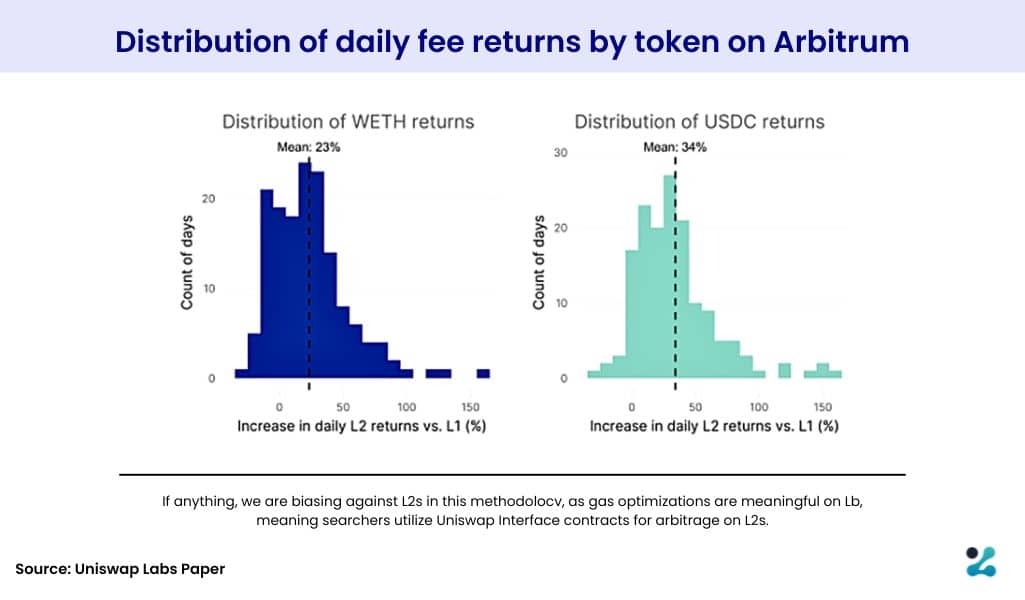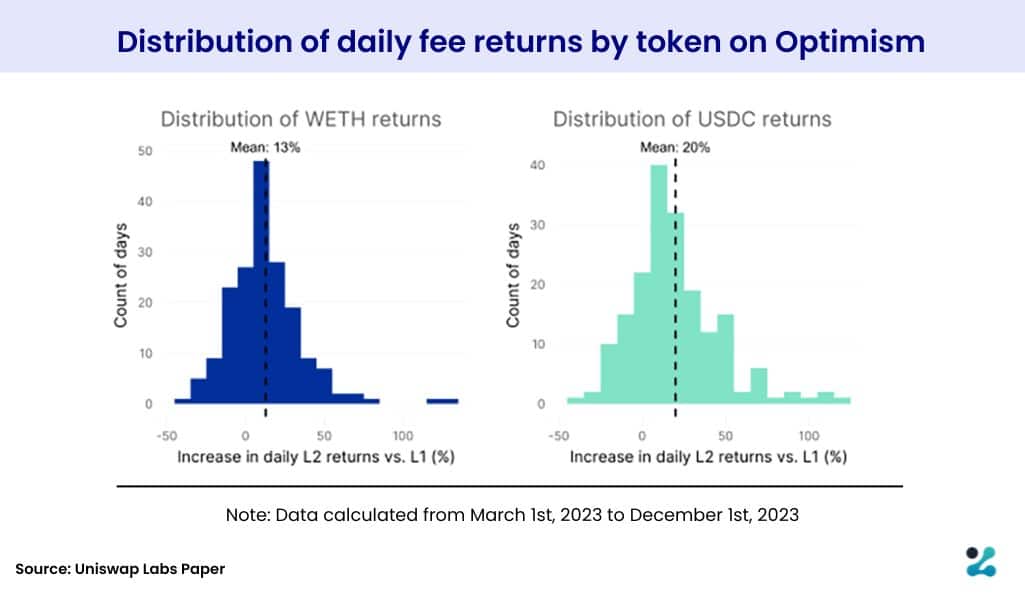- Zeeve
- Posts
- Arbitrum Orbit’s Fast & Elastic Block Times: Two Killer Features You Can’t Ignore
Arbitrum Orbit’s Fast & Elastic Block Times: Two Killer Features You Can’t Ignore

Arbitrum Orbit is poised to launch new features and vital upgrades to remain a leading Optimistic rollup stack powering top OP chains like XAI blockchain (62.26% TVL contribution), Sanko (37.66% TVL contribution), and Rari chain (0.08% TVL contribution).
Let’s discuss two of Arbitrum Orbit’s innovative features about Arbitrum Orbit block time. These are Fast block time and Elastic block times. Both these features allow Arbitrum Orbit to be more mainnet-aligned and mature, thus remaining one of the preferred choices of L2 developers.
This article details end-to-end analysis of both Fast & Elastic block time, allowing everyone to understand these features, their importance for Layer2s, and Arbitrum’s approach to offering them.

What is fast block time?
The fast block time is one of Arbitrum Orbit’s top-notch features that powers L2/L3 chains to offer an extremely low block count of up to 100 milliseconds. This is possible with easy configuration. Any Orbit chain can leverage Arbitrum Orbit block times to improve user experience with faster blocks and the benefits coming from this. We will discuss them later.
Why Orbit chains need this fast block time?
Fast block times in Arbitrum Orbit block times offer a range of benefits to Orbit chains. However, let’s now focus on two main aspects.
The first and obvious advantage is the faster response time for chain users, which delivers a great user experience with:
High Transaction Speed: Faster block times significantly reduce the time required to conform and add user transactions into blocks. When speed is high, the throughput (TPS) automatically boosts. Hence, Orbit chains with fast block time offer rapid transaction speed and a more responsive user experience with reduced latency.
Enhanced User Experience: Speed and performance are two main factors that make user experience seamless on any Layer2. With Arbitrum Orbit’s fast block time, users enjoy really faster confirmations and interactions, which encourages user retention and further adoption.
More stable Security: By reducing the confirmation time, Fast block time saves Arbitrum Orbit chains from potential attacks and blockchain-related frauds. With high throughput, a system can quickly detect and respond to issues, thus preventing attacks like liveness denial, censorship, 51% attack, double spend, and more.
Coming to the second advantage of Arbitrum Orbit’s fast block time is a little subtle but very important for Orbit chains. Faster blocks allow financial markets to become more versatile for attracting more liquidity and opening up to endless market opportunities.
This aspect is explained well in a comparison table of Uniswap Labs Paper.


In the above 4A vs 4B table, we can see that liquidity providers are achieving better ROI with faster block times. That’s because fast blocks do not allow arbitragers to extract higher values or exploit stale prices. With a standard ‘LVR with fees’ model, L2 networks can allow arbitrages to scale with the square-root of the block time. Hence, it is predicted that Arbitrum Orbit’s 250ms block time can result in 65% lower loss in arbitrage as compared to the 2-second block time.
As we can see, this option is lucrative to users. Higher return attracts more liquidity providers, and a high amount of liquidity leads to better opportunities for trading & investment. That’s one of the prime reasons why Arbitrum Orbit chains are a preferred option over other DeFi L2s when it comes to offering more liquidity for a complete organic form of trading.
How Arbitrum Orbit offer fast block time?
Now that we know the advantages let’s understand how Arbitrum Orbit enables this fast block time. Again, Arbitrum talks about two different reasons for this.
The first and the obvious one is the design of Arbitrum’s current sequencer, which the engineering team from Offchain Labs has created to handle extremely fast blocks.
The second and subtle reason is the shift of sequencer’s design from ‘block building’ to a ‘sequencing model’. In block building, a convention process is followed where:
>A block is published
> The block is made visible to everyone
> Transaction for the next block is submitted
> All the incoming transactions are gathered in mempool (until the deadline reaches)
> The system again prepares the next block after arranging transactions from the mempool.
And, this cycle keeps repeating.
Although this block building mode is advantageous in many ways, it will struggle a lot to offer a block time of 250 milliseconds.
On the flip side, Sequencing works differently. It packs the transactions immediately upon their arrival while simultaneously filtering out invalid transactions. And, as soon as the schooled time of the next block arrives, it publishes blocks (unless they are empty) and again starts over. No need to stop/ wait or force transactions to go into a mempool awaiting the final decision.
Simply put, sequencer is able to offer fast block time because it sequences each transaction instantly while also publishing the blocks as soon as they are ready.
Additionally, Arbitrum Orbit plans to take its existing sequencing model to the next-level with MEV monetization and Decentralized Sequencing. This means, Arbitrum Orbit will become even more powerful and complete stack with time.
What is Elastic block times?
Elastic block times is another leading innovation on the Arbitrum Orbit ecosystem that distinguishes it from L2 competitors in Optimistic rollups. Through this feature, Orbit chains produce blocks with superfast UX– up to 4 times every second. But what’s more interesting is that when a block goes without transactions, there will be no block in this instance. This means, you don’t need to pay for empty blocks.
Note that Elastic block time is designed for Orbit chains that are more likely to see spiky transactions. Mature chains like Arbitrum One are not concerned about empty blocks because they ensure stability in transactions. Meanwhile, for new chains, there are more possibilities of hiccups in transactions. Hence, with Elastic block time, these chains can automatically adapt to the rising/declining scaling demand.
How Elastic block time work?
To simply understand how Elastic block time works, let’s compare Elastic block times with its conventional alternative– Fixed block time.
For example, there’s an L2 chain that is accountable for producing blocks every 2-3 seconds. Its accountability for block production will remain the same both in case of transactions and no transactions. Therefore, Let’s say the chain has a 700K lifetime block count, its user transactions can differ, which can be 50K, 40K, or anything not matching the blocks.
However, if it’s an Orbit chain powered with Elastic block time, blocks will be produced exactly proportionally to the user transactions. This means, if there are 50K user transactions, the block produced would be exactly 50K.
This automatic adaptability in block count allows chains to be superfast while also saving cost by not paying for settlement of empty blocks on Layer1.
Why Elastic block time is so important?
Significant cost saving: As discussed, the elimination of empty block production is directly associated with reducing the cost that would otherwise be incurred on Layer1 mainnet. Also, the overall cost of maintaining the chains and their operations reduces when blocks are produced in accordance with the transactions.
Great UX with on-demand scaling: With Elastic block time, Arbitrum Orbit changes leverage on-demand scaling to adjust TPS and speed as per the current demand. The chain essentially goes superfast in case of massive transactions and it slows down when traction is low. Hence, Elastic block time allows for a great user experience.
Support new projects: New Orbit chains initially experience hiccups in transaction volume. Elastic block times enable them to avoid inefficiencies caused due to fixed block times during low activity periods. Also, elastic block time supports proper utilization of resources in these chains, which cut down the cost of resources required to manage empty blocks.
Launch your next-gen Orbit chain with Zeeve RaaS
All the next-level innovations, upgrades, and features of Arbitrum Orbit have been encouraging a lot of web3 to build their high-performance Optimic rollup Layer2/Layer3s. If you plan the same, Zeeve RaaS can be your perfect solution for a seamless launch. With Zeeve RaaS, you get 40+ advanced 3rd party integrations to enable modularity in your L2/L3s. There are alternative DA layers, decentralized sequencers, MPC wallets, account abstraction layers, custom explorers, data indexers, and more.
Additionally, you can set up mainnet-ready testnets for L2s with all the leading rollup solutions, be it Arbitrum Orbit, OP Stack, Polygon CDK, or ZK Stack Hyperchain. For this, Zeeve RaaS offers a 1-click deployment tool that allows for modular testnet setup within minutes. Try the sandbox tool or connect with our experts if you want to know more about our blockchain-related services.